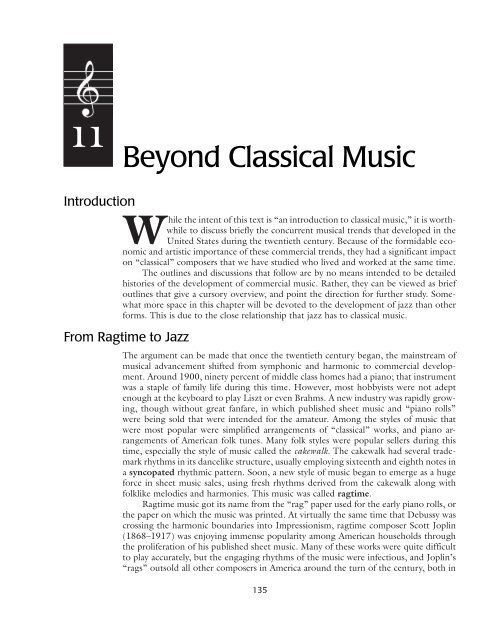Composer Profile - Activefolio
Composer Profile - Activefolio
Composer Profile - Activefolio
Create successful ePaper yourself
Turn your PDF publications into a flip-book with our unique Google optimized e-Paper software.
11<br />
Introduction<br />
Beyond Classical Music<br />
While the intent of this text is “an introduction to classical music,” it is worthwhile<br />
to discuss briefly the concurrent musical trends that developed in the<br />
United States during the twentieth century. Because of the formidable economic<br />
and artistic importance of these commercial trends, they had a significant impact<br />
on “classical” composers that we have studied who lived and worked at the same time.<br />
The outlines and discussions that follow are by no means intended to be detailed<br />
histories of the development of commercial music. Rather, they can be viewed as brief<br />
outlines that give a cursory overview, and point the direction for further study. Somewhat<br />
more space in this chapter will be devoted to the development of jazz than other<br />
forms. This is due to the close relationship that jazz has to classical music.<br />
From Ragtime to Jazz<br />
The argument can be made that once the twentieth century began, the mainstream of<br />
musical advancement shifted from symphonic and harmonic to commercial development.<br />
Around 1900, ninety percent of middle class homes had a piano; that instrument<br />
was a staple of family life during this time. However, most hobbyists were not adept<br />
enough at the keyboard to play Liszt or even Brahms. A new industry was rapidly growing,<br />
though without great fanfare, in which published sheet music and “piano rolls”<br />
were being sold that were intended for the amateur. Among the styles of music that<br />
were most popular were simplified arrangements of “classical” works, and piano arrangements<br />
of American folk tunes. Many folk styles were popular sellers during this<br />
time, especially the style of music called the cakewalk. The cakewalk had several trademark<br />
rhythms in its dancelike structure, usually employing sixteenth and eighth notes in<br />
a syncopated rhythmic pattern. Soon, a new style of music began to emerge as a huge<br />
force in sheet music sales, using fresh rhythms derived from the cakewalk along with<br />
folklike melodies and harmonies. This music was called ragtime.<br />
Ragtime music got its name from the “rag” paper used for the early piano rolls, or<br />
the paper on which the music was printed. At virtually the same time that Debussy was<br />
crossing the harmonic boundaries into Impressionism, ragtime composer Scott Joplin<br />
(1868–1917) was enjoying immense popularity among American households through<br />
the proliferation of his published sheet music. Many of these works were quite difficult<br />
to play accurately, but the engaging rhythms of the music were infectious, and Joplin’s<br />
“rags” outsold all other composers in America around the turn of the century, both in<br />
135



